Welcome! For a lot of gamers out there, we might not have a large group of people that we can play with on a regular basis. For many of us, our main gaming partners are our significant others or our children or our roommates or a coworker or… well, you get the drift. Whatever the case may be, often times we find ourselves sitting across the table with just one other person with nothing to do. In this series of articles, we will be turning our focus on some great 2-player only games that can fill that void!
Overview
Today we’ll be talking about Fields of Arle. In this mostly autobiographical game designed by Uwe Rosenberg, the players will be taking on the roles of farmers in the German region of East Frisia. Once known for its excellent farmland, Arle was one of the most prosperous areas in the region. The farmers there quickly grew very wealthy and successful. Fields of Arle guides the players through this time period as they watch their homesteads grow in both girth and abundance.
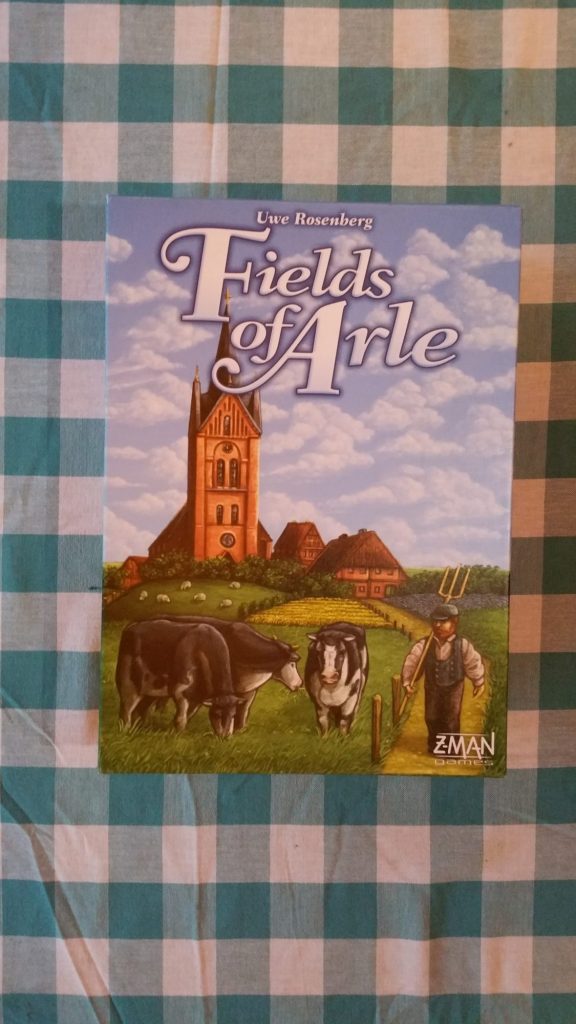
The game takes place over nine half-seasons. In between the players is a shared action board that the players will be able to select actions from each round. Some actions are upgradeable which makes them more efficient and bountiful when they are selected. Some actions allow the players to build up their infrastructure and increase their holdings. The players will also have opportunities to trade their goods with neighboring villages to earn victory points and much-needed food. In the end, Fields of Arle is a game about scoring victory points and the player that winds up with the most is the winner. Fields of Arle is a very large game both in size and scope, so I will do my very best to give you a sense of the game without going into a ton of detail.
Components and Setup
Fields of Arle is massive. There are a ton of components in this box. Among them are a number of different, double-sided resource tiles and building/location tiles, a starting player tile, and an orange season tracker. There are also a collection of transportation tiles and a whole host of wooden animals meeples in three different types- cattle, sheep, and horses – as well as some black peat cubes. Also included are a central action selection board and separate storage board where some of the tiles are placed at the beginning of the game as a central supply depot. These are all public, shared tiles, tokens, and boards. The boards should be arranged in the center of the table with the various tiles placed into their appropriate locations on the storage board and the various other resource bits placed somewhere close by within easy reach of both players. The action selection board also has spaces for different colored building tiles. A random assortment of buildings is selected and placed in their various locations – blue building tiles on blue spaces, green on green, etc.
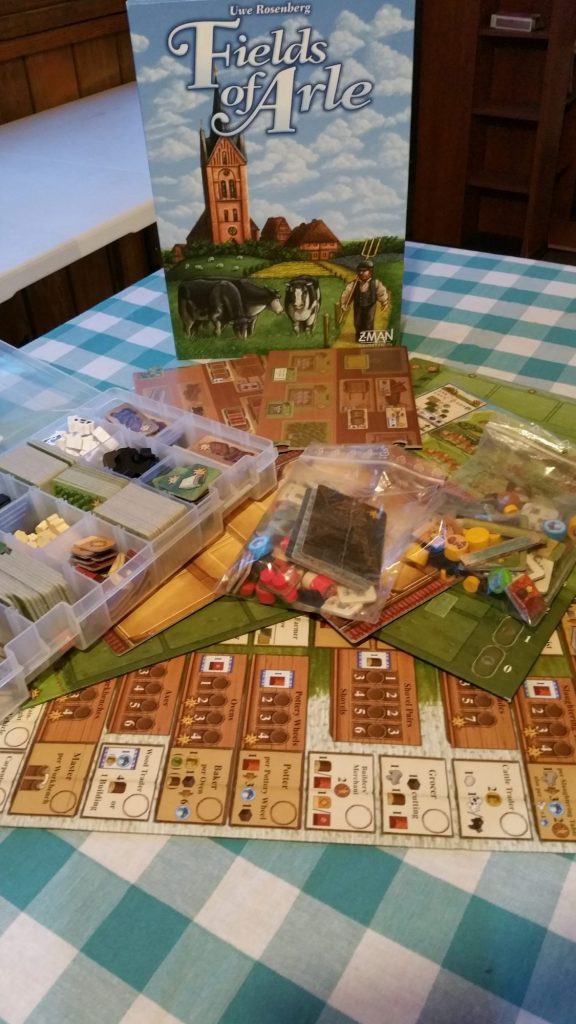
Separately, each player will also receive their own farmstead board, location board, and garage (which is where they will be storing vehicle tiles that they may purchase during the course of the game). The players will also select one of the two available colors and receive all of the pieces associated with that color: four workers, several small ‘tool’ discs, several double-sided location tiles, and several different colored resource trackers. Additionally, each player will also begin the game with 1 wheat tile, 1 flax tile, 1 stall building tile, 1 cut peat tile, and 1 horse from the central supply as well as 5 dikes. These various tiles will be placed on the matching, pre-labeled spaces on the player’s farmstead. Each of the resource markers is placed along the right side of the farmstead likewise. At the bottom of each farmstead is room for 3 peat bog tiles. These are placed in their proper locations with the “-4” facing upwards.

Each player will arrange their location tiles onto the location board with the place names facing upwards. The backside of these tiles has a picture of a road on it and this will be explained later. Once the players have set up their location boards and farmsteads, a first player will be selected and they will take the first player marker. Each player also receives 4 wood and 4 clay to start off the game with.
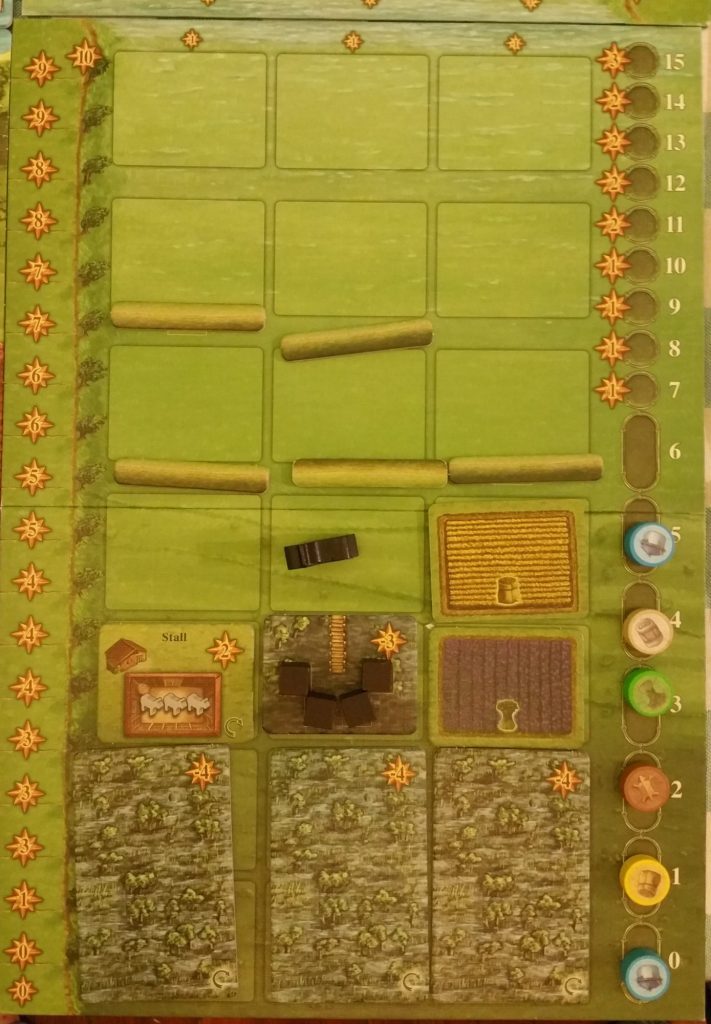
Next, the second player will place their workers into the bottom left section of the action selection board that is labeled “June Preparations”. Then they will place one of their tool discs into the leftmost circle of each of the brown tool spaces in the center column of the action selection board. The first player then follows suit placing their various tokens on top of the second player’s. The season tracker is placed into the number 1 spot at the bottom of the action selection board. With all of this out of the way, the players are ready to begin playing.

All of the components are of very good quality. You will definitely feel like you’ve gotten your money’s worth. Another interesting thing of note is the Almanac. If you’ve read any of my other reviews, you know that I love little extras like these that provide a lot of historical background information about the world in which the game takes place. In the Almanac for this game, Uwe Rosenberg has gathered together an interesting history of the region. His love for the region, its people, and its history shine through. While completely unnecessary, this extra feature really helps draw you into the game and I absolutely love it.
Anatomy of a Round
The game is divided into nine rounds. Each of these rounds represents a season – summer or winter. During the round, beginning with the start player, each player will take turns selecting a single action at a time using their workers. Once an action has been selected, it becomes unavailable for the rest of the round. The players are only able to select actions from the current season – with one exception. Once per round, one user only may select an out-of-season action. If they do so, they forfeit the right to go first in the following round. If a season comes to an end and neither player has selected an out-of-season action, the start player passes to the next player and the season comes to an end.
At the end of the season, any goods or location tiles placed into any vehicles will flip to their opposite sides and then be removed from their vehicles to their proper locations (more on this shortly). Then some end of season actions will be performed which vary depending on which season is coming to an end. These actions include breeding animals, feeding your workers, and producing resources from any resource production tiles that the players may possess. At the end of the ninth season, the game ends and final scoring is performed. The person with the highest score wins the game.
The Actions
Since there are so many actions in this game, I am just going to provide you with a very high-level overview of them. If you’d like to delve further into what’s available, then I encourage you to download the hefty, well-written, excellently illustrated rule book from Boardgamegeek. It can be found here. These actions are split into two different types – Summer and Winter actions. These can be further subdivided into several types of actions: actions that provide resources, actions that allow you to build things, actions that all you to buy vehicles, actions that allow you to improve your farmstead, and actions that allow you to improve the efficiency of other actions. Selecting an action is as simple as placing your worker on top of the action space and doing whatever it says.

Workbenches
Going down the center of the action selection board are the workbenches which represent the tools that players have at their disposal: Axes, Shovels, Peat Cutter, Ovens, etc. Each of these tools is associated with specific actions. The Axes, for instance, are associated with the Woodcutter action which provides the player 1 wood for each Axe that he has. Each player begins with their marker on the 3 space of the Axes tool. Selecting this action would reward the player with 3 wood. However, by utilizing the “Master” action, the player could upgrade their Axes workbench so that they would have a greater number of axes at their disposal which results in a higher payout of wood should they select the Woodcutter action at some later point.
Farmstead Upgrades
There are various farmstead upgrades available and buildings which can be purchased and added to your farmstead. Some of these are resource producing upgrades. Some enable you to store your animals more efficiently so that they can breed (more on this later). Others, such as some of the buildings, will provide you with various one time or ongoing benefits. These buildings are purchased by paying the cost that is printed on the action selection board directly above the building. In order to add these structures to your farmstead, you’ve got to make room for them and this is accomplished in one of two ways – moving your dikes and cutting peat.
Moving dikes and cutting peat
When moving dikes, they should be moved one at a time such that there is always a straight line of dikes running across the player board. Any empty space behind this line of dikes can have buildings or other upgrades placed into it. Cutting peat requires you to take an action to do so. One tile is available at the beginning of the game which you only have to remove the peat from. When the peat is all cleared away, the tile is removed from the farmstead and the space beneath it becomes available for building. The peat bogs, however, must be flipped over first (drained) before the peat can be removed from them. This is accomplished by using the proper action on the action selection board or by constructing a building which allows you to flip something.

Building vehicles
An important aspect of this game is the whole process of trading with the neighboring towns and villages. This is how you convert your generic goods and resources into more valuable goods and resources. All of the goods and resources in the game have a victory point value. By trading these, the value of them increases. Trading goods is also a valuable source of food and that becomes important later on. But, in order to trade, you’ve got to have vehicles to do so. Vehicles are purchased from the supply board by utilizing the appropriate action of the action selection board. Any purchased vehicles are placed into your garage. Your garage can only accommodate a certain number of vehicles, though, so take care when selecting the vehicles that you want to have at your disposal.
End of Round Actions
At the end of each round, certain actions are performed depending on which season is coming to an end. Firstly, regardless of season, any items that have been placed on a vehicle for transport become transported. They are flipped to their opposite sides and placed into their proper locations. Transported resources and goods go into the player’s personal supply. Location tiles, however, are placed onto the point track along the left-hand side of the player board in a line so as to form a road. As this road is formed, the numbers that are present get covered up and the player is going to earn points at the end of the game equal to the lowest uncovered number.
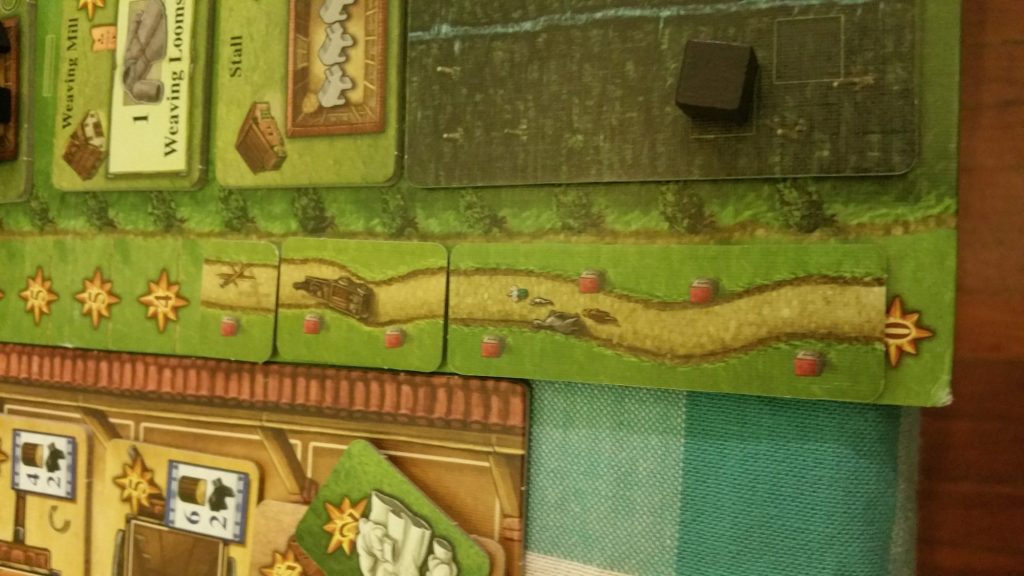
After the deliveries have been made, the seasonal end of round actions will occur. In the summer, the players receive food from their cattle and their sheep. Then their resource production tiles produce the appropriate resources. Finally, the player will have to pay food and peat into the supply. In the winter, after making their deliveries, the animals will breed as long as at least two of them are in a stall or a stable and as long as there is room for the baby animal on the farmstead. Regardless of how many animals of a single type the player has, they will only receive one new animal of that type. After breeding, the player’s sheep produce wool and then, as in the summer, the player must pay some food into the supply. However, during the winter, the peat is not needed.
Making Deliveries
I’ve mentioned making deliveries several times, so let’s take a moment to talk about how that is accomplished and what the benefits of doing so are. In order for this to make more sense, let’s consider the following example:

In this example, the player has two vehicles in their garage and they have opted to make a delivery to Aurich, a delivery to Bremen, and also some clay. Delivering clay requires a peat cube to be paid before it can be flipped to its “1” side. In this example, the peat has already been paid. Looking at the Aurich tile, we see three possible delivery options:
1 leather for 4 food, 1 animal of any type for 4 food, and 1 horse for 5 food
Bremen is similar with the following options:
1 lumber (upgraded wood) for 5 food, 2 animals for 9 food, 1 cloth, 1 leather, and 1 bolt of silk for 12 food, and 1 robes, 1 boots, and 1 shirt for 30 food
Bremen will additionally allow you to remove a Peat bog tile from your homestead for free.
When you make deliveries to locations, you can choose to make one, a few, or ALL of the deliveries pictured. In the case of Aurich, the player has opted to only make 1 of them. In Bremen, however, the player has opted to make 3 deliveries. These deliveries are going to generate a whopping total of 48 food for this player this turn. These location tiles will then be flipped over and placed onto the road area of the farmstead board. The clay is removed and kept in the player’s supply. If it doesn’t get used by the end of the game, it’ll be worth 1 victory point.
Scoring
At the end of the game, the players are going to add up their scores using the score pad provided with the game. They will earn points for the buildings they have built, points for resources collected, points for animals, points for leftover resources and goods, points from the workbenches on the action selection board, points from the road section of the farmstead, and bonus points provided by some of the buildings. There are also negative points which may be received from having an empty garage or having peat bogs leftover or not having the dikes moved up all the way. In short, if there is a star with a number inside of it, the players have the potential to earn positive or negative points from it at the end of the game. Once the players have added up their scores, the player with the highest score wins.

Thoughts
I’ve already gushed about the Almanac and I will reiterate that I think these kinds of little extras are some of my favorite things in board games. I really enjoy this Almanac and, even though it is completely superfluous, I am very glad that it’s here. Also, I really enjoy the artwork in this game. Dennis Lohausen has done the artwork for many of my favorite games including Aquasphere, Terra Mystica, Village, and many others. As with all of those other games, he has done a phenomenal job here. One of my favorite little artistic touches, in particular, is the game box itself. If you look on the edges of the box, you will actually see the same scenes at different times of the year. I think that’s just awesome.
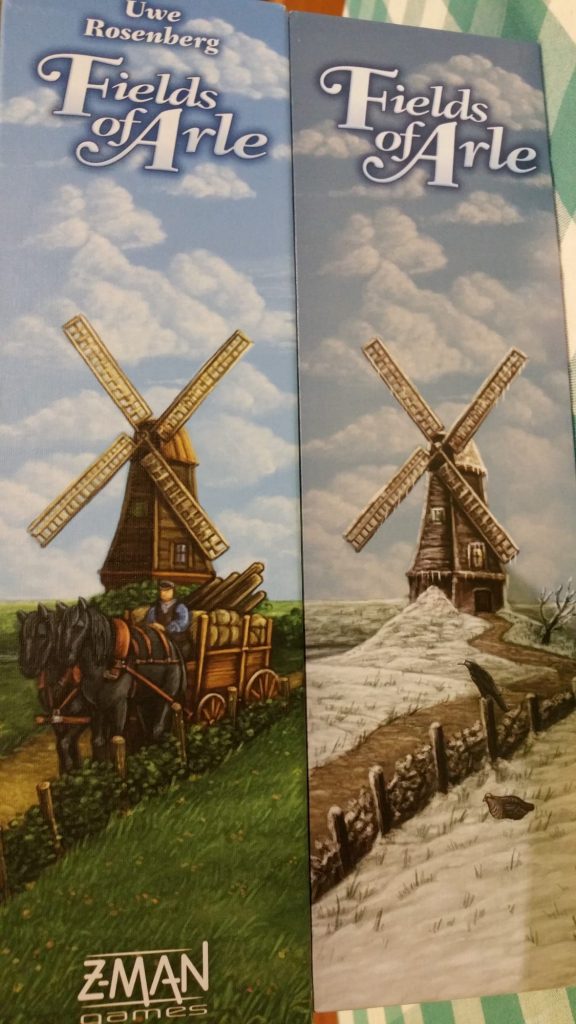
As I mentioned at the beginning of this review, Fields of Arle is a behemoth of a game. While I might open the box and see a wealth of possibility and start salivating over it, there are inevitably going to be others that feel the exact opposite. The game’s size is also reflected in its price. It certainly isn’t a cheap game and that might also turn some people away. However, if you can get past these barriers to entry, you will discover one of the most delightful and pleasing two player experiences that you’ve ever encountered.
This is a game rife with possibilities. At the beginning of the game, it can be a little difficult deciding what to do first, but once those actions begin disappearing from the board, your options become more limited and this really helps to give you focus and direction. Since there are a lot of ways to earn points, it pays to pursue a little bit of everything, but it also helps to specialize as well. Maybe this game your goal will be to focus on delivering goods. Maybe the next one you’re going to want to focus on building up your farmstead and erecting lots of buildings. There are always interesting decisions to be made, some more agonizing than others. No two games ever play the same and it’s never obvious who’s winning until the final scores are tallied. It’s because of this that this game has quickly become one of my favorites – and I’m not alone. There’s a reason this game is in the top 100 games on Boardgamegeek. It’s just THAT good.
In short, if you’re looking for a beautiful two player game with a lot of depth, then you couldn’t go wrong with Fields of Arle.




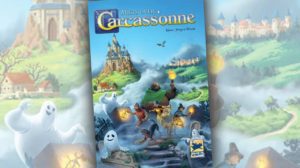
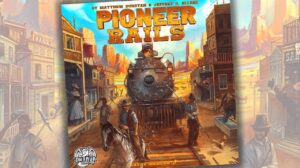

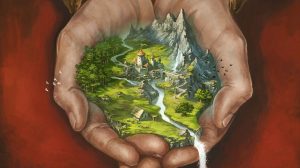




Add Comment